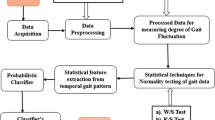Abstract
The gait characteristic features can be used for various diseases source and level diagnosis. The interferences of a physiological data record caused by any characteristic abnormal data spectrum (of the disease) corresponds to the disease source and level. The disease source can easy be classified by the relevant periodical functions. The interferences characteristics were analysed then matched to the well defined mathematical expressions for doing several manipulations on the data set. Knowing a range of the data records disorders the physiological data record can be modified due to multiply the data set of the defined disease class. This way the efficient amount of the data for the neural network training can be obtained. The paper shows several aspects of the gait data record analysis concerning two neurological diseases.
Access this chapter
Tax calculation will be finalised at checkout
Purchases are for personal use only
Preview
Unable to display preview. Download preview PDF.
Similar content being viewed by others
References
Chandzlik S, Kopicera K (2000) Experiments with neural network parameters-selection for foot abnormalities recognition. Journal of Medical Informatics & Technologies MIT 5:CS-71–CS-78
Chandzlik S, Piecha J (2003) The body balance measures for neurological disease estimation and classification. Journal of Medical Informatics & Technologies MIT 6:IT-87–IT-94
Chandzlik S, Piecha J (2002) A patient walk-data-record modelling using a spline interpolation method. Journal of Medical Informatics & Technologies MIT 3:MIT-153–MIT-160
Kopicera K, Piecha J (2001) The fuzzy estimation unit of foot-print abnormality recognition. Journal of Medical Informatics & Technologies MIT 2:MI183–MI188
Kopicera K, Piecha J, Zygula J (1999) The neural networks in diagnostics support for PSW system. Proc. of Int. Conference ASIS’99:113–118
Piecha J (2000) The neural network conclusion-making system for foot abnormality recognition. Proceedings of IMACS World Congress, Lausanne
Pieha J (2001) The neutral network selection for a medical diagnostic system using an artificial data set. Journal of Computing and Information Technology CIT 9:123–132
Piecha J, Zygula J, Lyczak J, Gazdzik T, Proksa J (1996) The advanced measuring system for orthopaedic pathologies diagnostics using a static and dynamic footprints. Chirurgia narzadow ruchu i ortopedia polska LXI, suplement 3B:119–124 (in Polish)
Zbrojkiewicz J, Piecha J, Jarzabek-Stepniak A (2001) The gait pattern detection in PSW records of the acute sciatic neuralgia. Proc. on KOSYR’01:29–36
Author information
Authors and Affiliations
Editor information
Editors and Affiliations
Rights and permissions
Copyright information
© 2005 Springer-Verlag Berlin Heidelberg
About this paper
Cite this paper
Chandzlik, S., Piecha, J. (2005). The Gait Characteristic Data Spectrum Extraction. In: Kurzyński, M., Puchała, E., Woźniak, M., żołnierek, A. (eds) Computer Recognition Systems. Advances in Soft Computing, vol 30. Springer, Berlin, Heidelberg. https://doi.org/10.1007/3-540-32390-2_58
Download citation
DOI: https://doi.org/10.1007/3-540-32390-2_58
Publisher Name: Springer, Berlin, Heidelberg
Print ISBN: 978-3-540-25054-8
Online ISBN: 978-3-540-32390-7
eBook Packages: EngineeringEngineering (R0)




